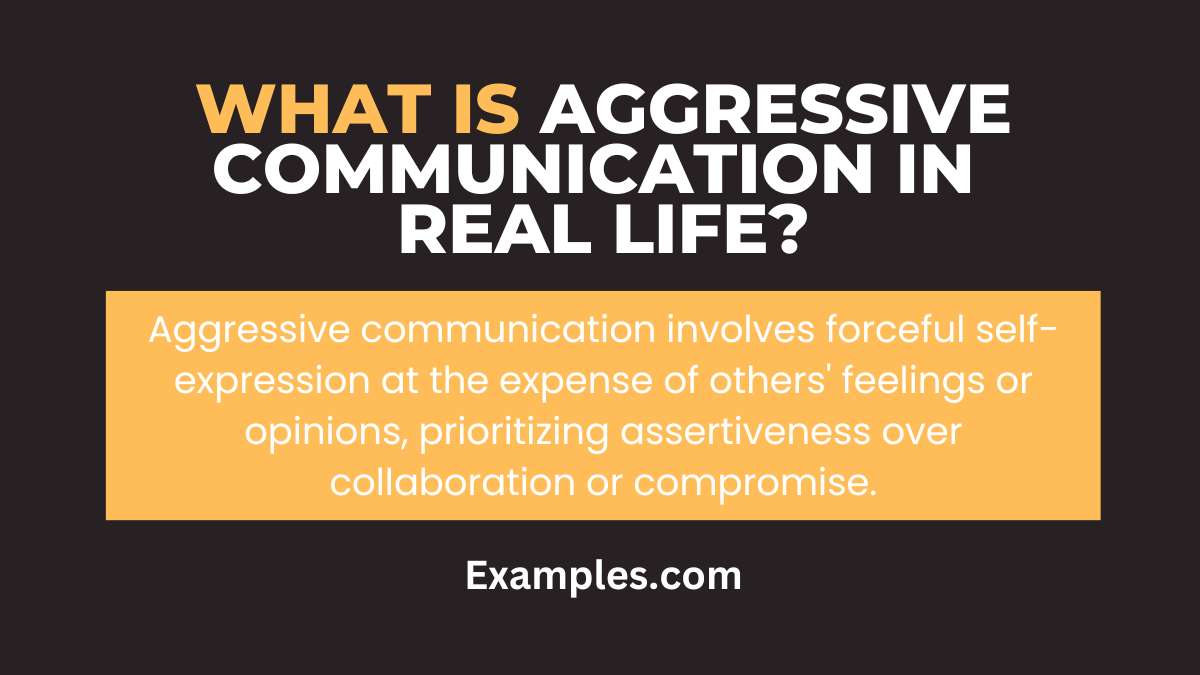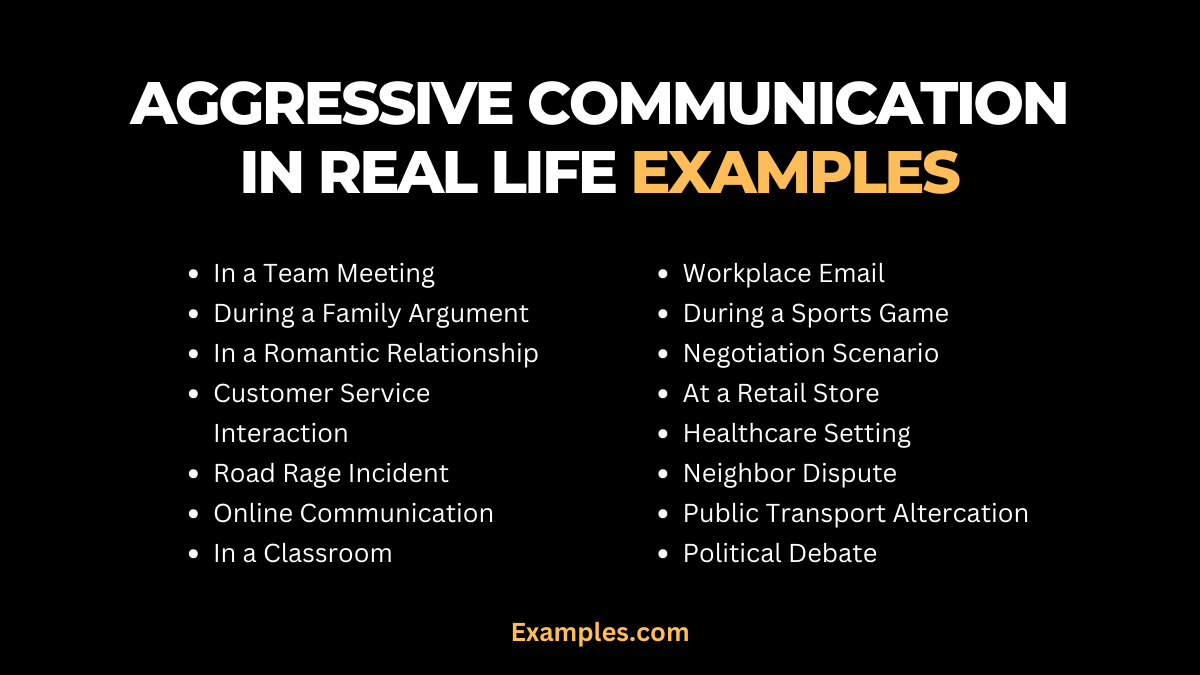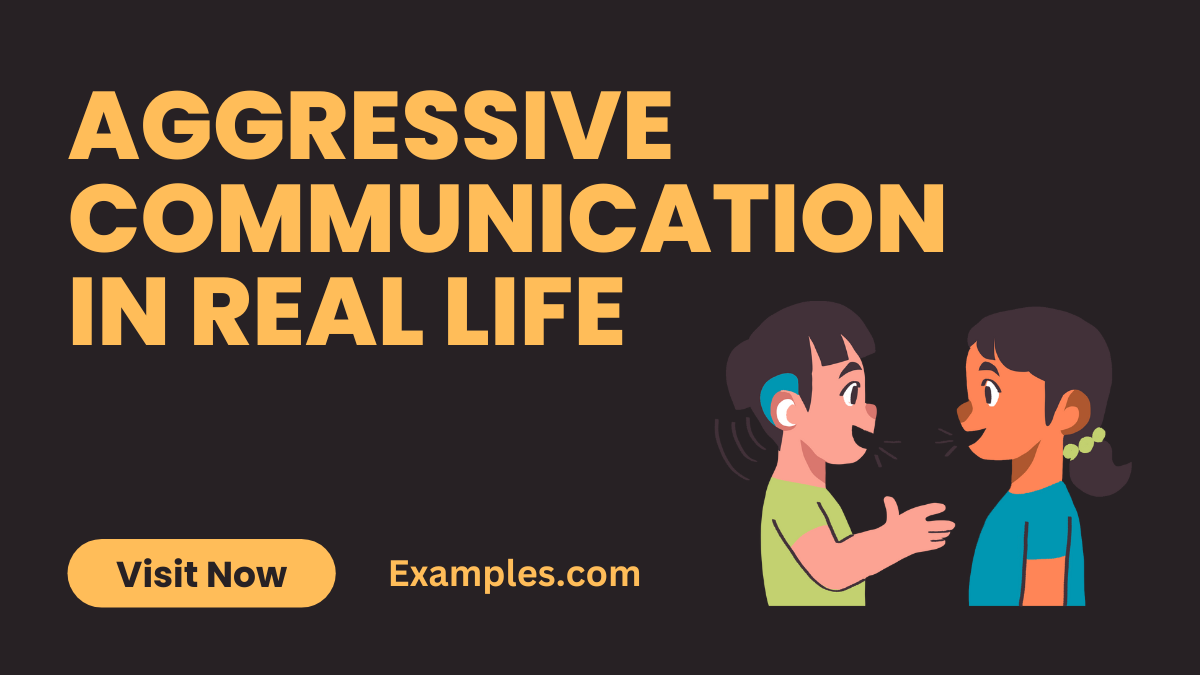14+ Aggressive Communication in Real Life Examples
In our journey through diverse communication styles, “Aggressive Communication in Real Life” stands out for its directness and intensity. Often contrasted with passive approaches, this form of interaction can be both empowering and challenging. It’s essential to understand its dynamics to navigate various social and professional landscapes effectively. This comprehensive guide delves into real-life examples of aggressive communication, offering insights into its use and impact. We’ll explore strategies to harness its potential while maintaining respectful and effective dialogues.
What is Aggressive Communication in Real Life?

Aggressive communication in real life refers to a style of interaction where individuals express their needs, opinions, and feelings in a direct, often forceful manner. This approach is characterized by assertiveness taken to an extreme, sometimes at the expense of others’ feelings or opinions. Unlike passive communication, where one’s own needs are often suppressed, aggressive communication prioritizes self-expression, often with a lack of regard for collaboration or compromise. Understanding this style is crucial for recognizing its presence in various contexts and learning to respond effectively.
15 Aggressive Communication in Real Life Examples

- In a Team Meeting: A manager sharply rebukes an employee for a minor mistake.
Example Sentence: “This is unacceptable, you always make these careless errors!” - During a Family Argument: One family member interrupts others, raising their voice to dominate the conversation.
Example Sentence: “I don’t care what you think, I’m right and that’s final!” - In a Romantic Relationship: A partner uses blame to avoid responsibility.
Example Sentence: “It’s all your fault that we’re in this mess!” - Customer Service Interaction: A customer loudly complains, belittling the staff.
Example Sentence: “You have no idea what you’re doing, do you?” - Road Rage Incident: A driver yells and gestures aggressively at another motorist.
Example Sentence: “Learn how to drive, idiot!” - Online Communication: Aggressive and critical comments on social media.
Example Sentence: “Only an idiot would think like that!” - In a Classroom: A teacher sternly reprimands a student in front of the class.
Example Sentence: “You’ll never succeed if you keep this up!” - During a Sports Game: A coach loudly criticizes a player’s performance.
Example Sentence: “You’re ruining the game for everyone!” - Workplace Email: Sending curt, commanding emails without pleasantries.
Example Sentence: “Fix this report immediately. I expect better.” - Negotiation Scenario: Using intimidation tactics to get a better deal.
Example Sentence: “Take it or leave it, I won’t accept anything less.” - At a Retail Store: A shopper rudely demands service.
Example Sentence: “I want to speak to your manager now!” - Healthcare Setting: A patient angrily questioning a doctor’s competence.
Example Sentence: “What kind of doctor are you, anyway?” - Neighbor Dispute: Loudly complaining about a neighbor’s habits.
Example Sentence: “You need to control your pets, they’re a nuisance!” - Public Transport Altercation: Confronting another passenger rudely.
Example Sentence: “Move over, you’re taking up too much space!” - Political Debate: Using personal attacks instead of discussing issues.
Example Sentence: “Only a fool would believe in your policies!”
Types of Aggressive Communication in Real Life Psychology

Aggressive communication, in the realm of real life psychology, can manifest in various forms, each with distinct characteristics and implications. Understanding these types helps us to better navigate and respond to such interactions.
- Verbal Aggression: This involves using words to hurt or dominate others. It can include yelling, harsh criticism, or threats. Unlike assertive communication, which is respectful, verbal aggression disregards the feelings of others.
- Physical Aggression: Although less common in everyday situations, physical aggression involves using bodily actions to intimidate or harm. It’s a stark contrast to passive communication, where physical actions are often subdued or non-existent.
- Passive-Aggressive Communication: A subtle form of aggression, this involves expressing negative feelings indirectly. It’s a hybrid of passive and aggressive styles, where the communicator may appear passive on the surface but is actually hostile underneath.
- Direct Aggression: This is straightforward and blunt, often involving direct confrontation. It’s quite the opposite of indirect communication, where messages are conveyed in a roundabout way.
- Intimidating Aggression: This type involves creating a fear-inducing environment to control or manipulate others. It’s a more extreme form of aggressive communication, diverging significantly from the principles of nonviolent communication.
What Defines Aggressive Communication in Real Life Contexts?
Understanding what constitutes aggressive communication in real-life contexts is crucial for effective interpersonal relations.
- Dominance over Dialogue: Aggressive communication is characterized by a desire to dominate rather than engage in a mutual dialogue. Unlike effective communication, which involves listening and understanding, aggression focuses on overpowering the other person.
- Lack of Empathy: It often lacks empathy and understanding, traits central to therapeutic communication. The aggressive communicator pays little attention to the feelings or perspectives of others.
- Control and Intimidation: Unlike internal communication strategies that aim to build team cohesion, aggressive communication often seeks to control or intimidate others.
- Hostile Nonverbal Cues: Aggressive communication isn’t just about words; it includes nonverbal cues like aggressive body language and facial expressions, differing from the subtleties of nonverbal communication.
- Resistance to Feedback: Aggressive communicators often resist open and constructive feedback, a cornerstone of professional communication.
What is the Impact of Aggressive Communication in Real Life?

The impact of aggressive communication in real-life scenarios can be profound and far-reaching.
- Damaged Relationships: Aggressive communication often leads to strained relationships, both personally and professionally. It’s counterproductive to the principles of interpersonal communication and team communication.
- Reduced Collaboration: In a workplace, aggressive communication can hinder teamwork and collaboration, essential aspects of corporate communication and organizational communication.
- Increased Stress and Anxiety: Unlike the calmness promoted by mindful communication, aggressive interactions often result in increased stress and anxiety for all parties involved.
- Conflict Escalation: Aggressive communication tends to escalate conflicts rather than resolve them, contrary to the objectives of conflict resolution communication.
- Hindered Personal Growth: Continuous aggressive communication can impede personal and professional growth, which requires open, empathetic, and effective communication skills.
Understanding aggressive communication in real life is crucial for healthier interactions. This guide offers insight into its forms, definitions, and impacts, providing valuable examples and strategies for effective communication. Embracing these learnings can lead to more empathetic, productive dialogues, fostering positive relationships both personally and professionally. Remember, the key is awareness and adaptability in our communication approach.



